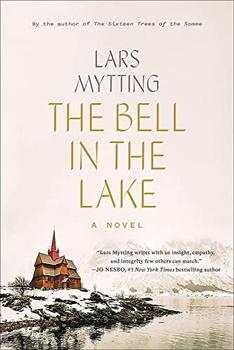Summary | Excerpt | Reading Guide | Discuss | Reviews | Beyond the Book | Read-Alikes | Genres & Themes | Author Bio

Sister Bells Trilogy #1
by Lars MyttingThis article relates to The Bell in the Lake
 It's no secret that Lars Mytting loves trees. He wrote a novel titled The Sixteen Trees of the Somme (2017), and is known for his international bestseller Norwegian Wood (2015), a nonfiction guide to sources of firewood that gives instructions on how to chop, stack and cure wood for burning. With The Bell in the Lake, he continues with the subject of wood as material by delving into Norway's architectural history, specifically its famous stave churches.
It's no secret that Lars Mytting loves trees. He wrote a novel titled The Sixteen Trees of the Somme (2017), and is known for his international bestseller Norwegian Wood (2015), a nonfiction guide to sources of firewood that gives instructions on how to chop, stack and cure wood for burning. With The Bell in the Lake, he continues with the subject of wood as material by delving into Norway's architectural history, specifically its famous stave churches.
While stone cathedrals were constructed elsewhere in the Middle Ages, in parts of northern Europe wood was the building material of choice. More than 1,000 stave churches were assembled in Norway, mostly in the 12th to 14th centuries. The name refers to the type of timber framing used. Viking boat- and home-building skills were applied to these medieval churches, which feature intricate carvings of real and mythical animals (such as dragons), and combine Norse and Christian symbology.
The stave churches were typically constructed in rural valleys and fishing villages, and ranged from simple chapels like Undredal Stave Church, which only seats 40 people, to elaborate multi-level constructions with tiered roofs and turrets like Heddal Stave Church, Norway's largest (see picture). Many of the buildings that are still standing have undergone multiple renovations and restorations, such that traces of different time periods are visible in the architecture and decoration, while others have been demolished and replaced. Replica stave churches, either replacements or doubles, can be found throughout Scandinavia and in other parts of the world. For instance, there is an exact replica of Hopperstad Stave Church in Vik, Norway at the Hjemkomst Center in Moorhead, Minnesota.
Only 28 original stave churches are still standing in Norway. One of the oldest is Urnes Stave Church, which is thought to have been built around 1130 and is on the UNESCO World Heritage list. Some are still active churches, with their cemeteries in use. Others are maintained primarily as historical sites and are only used for a limited number of services and events. For example, Flesberg Stave Church only hosts services in the summer. Certain churches can be visited for free, while others charge an entry fee.
While most existing original stave churches are located in Norway, there are rare notable exceptions. One is in Hedared, Sweden, and dates from c. 1500. Another is the 12th-century church that inspired The Bell in the Lake, Vang Stave Church, which was taken apart and moved from Norway in 1842 to be reconstructed in an area of Germany that is now Karpacz, Poland. Now attended by Polish Lutherans, the church is a major tourist attraction drawing 200,000 visitors every year.
Heddal Stave Church, Notodden, the largest stave church in Norway, by Micha L. Rieser
Filed under Cultural Curiosities
![]() This "beyond the book article" relates to The Bell in the Lake. It originally ran in October 2020 and has been updated for the
September 2022 paperback edition.
Go to magazine.
This "beyond the book article" relates to The Bell in the Lake. It originally ran in October 2020 and has been updated for the
September 2022 paperback edition.
Go to magazine.
Your guide toexceptional books
BookBrowse seeks out and recommends the best in contemporary fiction and nonfiction—books that not only engage and entertain but also deepen our understanding of ourselves and the world around us.